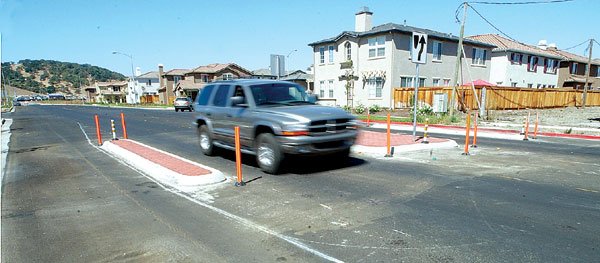Gilroy
– Residents moving into a new west Gilroy neighborhood may have
noticed something’s different about the street leading to their
homes.
It’s not that Sunrise Drive doesn’t have stop signs or bike
lanes. It does. But it also has three sets of islands placed smack
in the middle of the road, and some residents may be wondering
why
Gilroy – Residents moving into a new west Gilroy neighborhood may have noticed something’s different about the street leading to their homes.
It’s not that Sunrise Drive doesn’t have stop signs or bike lanes. It does. But it also has three sets of islands placed smack in the middle of the road, and some residents may be wondering why.
The red brick islands, situated between Hopi Lane and Ohlone Way, are meant to slow drivers who perceive the straight, wide contours of Sunrise Drive as a runway.
“The sole purpose of the channelizing islands is to modify speeds on Sunrise,” said city traffic engineer Don Dey. “Before houses went up in that area, people really were tempted to speed because that road is so wide open.”
Hopefully, Dey said, drivers on Sunrise now will perceive the road as narrower than before, and slow down accordingly. The speed limit on Sunrise is 40 mph, and there are three sets of stop signs.
When homes started to go up in 2003 in Western Pacific Housing’s Tapestry at Deer Park subdivision, the city received several concerned calls about speeding drivers in that area, Dey said. In response, the subdivision’s developer, D.R. Horton, suggested installing – and paying for – the islands to help calm traffic.
Each set of red brick medians consists of one large island – roughly eight feet by four feet – that sits in the middle of Sunrise Drive, accompanied by two smaller islands that sit just outside each bike lane.
The developer will monitor the neighborhood’s traffic patterns for one year to see if the islands really are slowing down traffic, Dey said. If they are, Dey said the city might consider having similar islands installed in other residential areas notorious for speeding, such as Mantelli Drive and Larkspur Lane. Several residents in that neighborhood have complained about excessive speeding, Dey said.
“Until we get the before-and-after results of the traffic study on Sunrise Drive and are able to see the impacts the islands had, we wouldn’t consider installing them in other areas,” Dey said. “The city doesn’t have the money to do that.”
One new resident of Laredo Way said he thinks the islands are a good safety precaution for a neighborhood that most likely be home to many children.
“There’s going to be a lot of families in this area, I think, so most likely there’ll be kids playing around here,” he said. “It’s good for safety reasons.”













